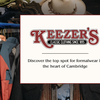At the Coop, the hat reached the consumer at a price of $18.98.
The Sweat Ahead
"If [the manufacturers] are not going to tell you I don't know of any other way that you could find out," he says.
But as Harvard waits for its apparel manufacturers to spill their beans, it is already preparing for the next step--monitoring. At issue is how to effectively keep tabs on conditions, while still giving companies their privacy.
In March, Harvard announced that it was joining the Fair Labor Association (FLA), a government-initiated partnership of businesses and other concerned parties that will start monitoring next year.
And amid concerns that the FLA is too soft on industry, Harvard has also made a one-year deal with four other universities to coordinate sweatshop policies and monitoring systems. It has also hired an accounting and consulting firm, PriceWaterhouseCoopers, to conduct the oversight.
Academic initiatives have also been spearheaded. Starting tomorrow, the Harvard Trade Union Program will host a two-day conference with leaders from business, academia, non-governmental organizations and the student movement against sweatshops. The conference will examine ways of working together on the sweatshop dilemma.
Read more in News
Weissmans WorldRecommended Articles
-
Markets' Dips Raise Concerns for Business-Bound SeniorsIt's been a ride wild enough to make job-hungry seniors and stockbrokers alike queasy. From a spectacular high of 9337.97
-
Professors Partner With Cambridge Biotech FirmsIn 1978, Loeb University Professor Walter Gilbert '53, left his post as a tenured professor in molecular and cellular biology
-
Harvard: Administration Watch-Dogs Keep Use of Harvard Name Under ControlWhat image does the name Harvard evoke? To some it is a brand of cigarettes marketed in India, a type
-
Two Approaches to SweatshopsLast week, two roads diverged for universities interested in ending sweatshops. The national student umbrella group, United Students Against Sweatshops,
-
Apparel Makes Disclose LocationsDalian Jialian Making Clothes Co. That's the name of the factory in Dalian, China where a yellow Gear For Sports
-
Apparel Factory Report Due After Year-Long ProbeHarvard and four other universities will announce the findings of a major joint report on worldwide apparel manufacturing today, said













